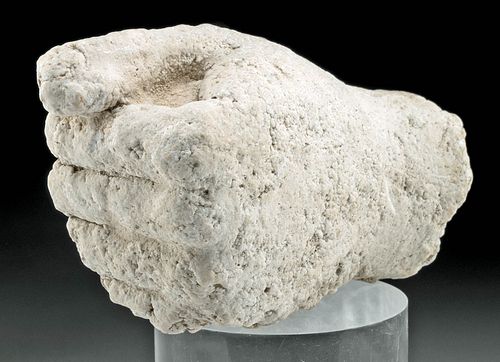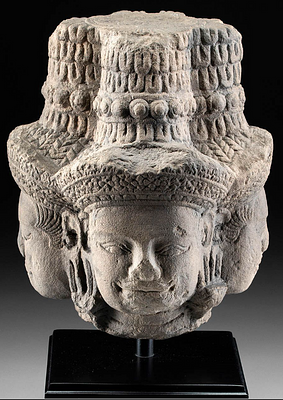Exhibited Egyptian Limestone Sculptor's Model of Fist
Lot 15
About Seller
Artemis Fine Arts
686 S Taylor Ave, Ste 106
Louisville, CO 80027
United States
Selling antiquities, ancient and ethnographic art online since 1993, Artemis Gallery specializes in Classical Antiquities (Egyptian, Greek, Roman, Near Eastern), Asian, Pre-Columbian, African / Tribal / Oceanographic art. Our extensive inventory includes pottery, stone, metal, wood, glass and textil...Read more
Estimate:
$1,600 - $2,400
Absentee vs Live bid
Two ways to bid:
- Leave a max absentee bid and the platform will bid on your behalf up to your maximum bid during the live auction.
- Bid live during the auction and your bids will be submitted real-time to the auctioneer.
Bid Increments
| Price | Bid Increment |
|---|---|
| $0 | $25 |
| $300 | $50 |
| $1,000 | $100 |
| $2,000 | $250 |
| $5,000 | $500 |
| $10,000 | $1,000 |
| $20,000 | $2,500 |
| $50,000 | $5,000 |
| $100,000 | $10,000 |
| $200,000 | $20,000 |
About Auction
By Artemis Fine Arts
Jun 29, 2023
Set Reminder
2023-06-29 10:00:00
2023-06-29 10:00:00
America/New_York
Bidsquare
Bidsquare : Exceptional Antiquities, Ethnographic and Fine Art
https://www.bidsquare.com/auctions/artemis-gallery/exceptional-antiquities-ethnographic-and-fine-art-13031
Artemis Fine Arts info@artemisgallery.com
Artemis Fine Arts info@artemisgallery.com
- Lot Description
Ancient Egypt, Late Dynastic Period, 26th to 31st Dynasty, ca. 664 to 332 BCE. A hand-carved limestone hand that was perhaps used as a reference model for a sculptor. The model left hand is clenched into a fist with the thumb overlaying the index finger in a natural position. Sculptors of all skill levels used models of various subjects, typically of human body parts when carving large or monumental sculptures. Size: 3.75" L x 1.6" W x 2.35" H (9.5 cm x 4.1 cm x 6 cm)
A closed fist like this example may have served as a model for a larger sculpture, to teach apprentice sculptors how to replicate a master style, or to produce ushabti figures (small funerary statues for tombs). Though sculptors' models are typically difficult to date - with some being from the Amarna period of the 18th Dynasty when new forms of statuary came in - most known examples are from the Late Dynastic and Ptolemaic periods. The Egyptians were keen observers of fauna, with many different animals gracing their mythology, artwork, and hieroglyphs; however, anthropomorphic models were typically among the most challenging to carve accurately.
While sculptors' models appear to be from larger composite figures, their incomplete presentation could be an entirely separate item typology. Ancient Greek sculptural incompleteness was a generic form of presentation as the viewer could extrapolate who or what a sculpture was meant to represent. In contrast, the ancient Egyptians would view an incomplete votive work of art only as it was: part of a bird, a disembodied head, or in one instance the hind quarters of a lion. The smooth surface at the top of this foot indicates that it is a complete object by itself. According to Eric Young of the Metropolitan Museum of Art, "When we consider the Egyptian pieces as sculptors' models, however, their incompleteness is no longer disturbing, but entirely understandable. As is the case with unquestioned sculptors' models...the apprentice sculptor concentrated his energies on those portions of the figure that he found intriguing, or most difficult, and the master sculptor demonstrated the correct way to delineate a head…" ("Sculptors' Models or Votives? In Defense of a Scholarly Tradition." The Metropolitan Museum of Art Bulletin, March 1964, p. 255).
Exhibited in the Robert and Frances Fullerton Museum of Art (RAFFMA), California State University, San Bernardino from 2007 to 2023, reference number EL01.008.2007.
Provenance: Collection of Dr. W. Benson Harer, Los Angeles, California, USA; Exhibited in the Robert and Frances Fullerton Museum of Art (RAFFMA), California State University, San Bernardino from 2007 to 2023, reference number EL01.008.2007.
All items legal to buy/sell under U.S. Statute covering cultural patrimony Code 2600, CHAPTER 14, and are guaranteed to be as described or your money back.
A Certificate of Authenticity will accompany all winning bids.
We ship worldwide and handle all shipping in-house for your convenience.
#178978Small chips and losses around hand, fingers, and wrist commensurate with age and environmental exposure, with darkening to some surfaces, light earthen and sand deposits, softening to some finer details, and roughness across most areas, otherwise in very good condition. This was likely a standalone model rather than a fragment from a larger composition. Nice preservation to overall form of hand. Number written on wrist.Condition
- Shipping Info
-
All shipping is handled in-house for your convenience. Your invoice from Artemis Gallery will include shipping calculation instructions. If in doubt, please inquire BEFORE bidding for estimated shipping costs for individual items.
-
- Buyer's Premium



 EUR
EUR CAD
CAD AUD
AUD GBP
GBP MXN
MXN HKD
HKD CNY
CNY MYR
MYR SEK
SEK SGD
SGD CHF
CHF THB
THB















